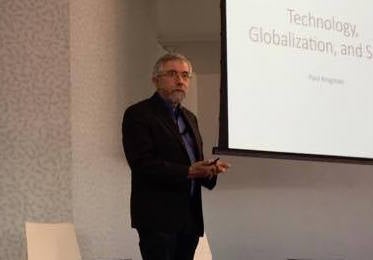This article was published in Scientific American’s former blog network and reflects the views of the author, not necessarily those of Scientific American
America has been struggling to keep up when it comes to science, technology, engineering and mathematics (STEM) education. The U.S. placed 35th and 27th out of 64 countries in math and science respectively according to the 2012 Program for International Student Assessment survey.
That stinks.
Today, Scientific American and Macmillan Learning held the STEM Summit 4.0 at the New York Academy of Sciences. Educators, entrepreneurs and government employees gathered in a space overlooking the lower Manhattan skyline to listen to and discuss strategies for teaching and engaging students in STEM topics. This year’s theme: The Power of Data.
On supporting science journalism
If you're enjoying this article, consider supporting our award-winning journalism by subscribing. By purchasing a subscription you are helping to ensure the future of impactful stories about the discoveries and ideas shaping our world today.
The day’s talks included involving children in paleontology research, using the Pokémon Go fad to empower students in using “social media for social good’” and how the New York Hall of Science’s “Connected Worlds” sustainability exhibit scales from three-year-olds to high schoolers. A few presentations stood out:
Dr. Rosemarie Truglio, the Senior Vice President of Curriculum and Content for Sesame Workshop, discussed reaching students earlier in their STEM education — as early as preschool. She explained that preschoolers are natural “STEM-ists,” which is to say eager STEM learners. But it’s up to parents to help kids engage with the environment and to support inquisitiveness. Sesame Street uses fan favorite Grover as a STEM spokesmonster, since he often fails. “That’s the point of scientific inquiry,” said Truglio: how to learn from error.
One panel discussed the importance of educating women. Some highlights:
Fewer women obtain STEM degrees than they did 30 years ago, said Terri McCullough, Director of the Clinton Foundation’s No Ceilings: The Full Participation Program.
Some of the deficit in women receiving STEM degrees stems from missing role models, said Blair Blackwell, Manager for Education and Corporate Programs at Chevron. She highlighted that parents don’t need STEM backgrounds to empower their daughters to study STEM.
Some mentoring can be done remotely, especially when trying to reach students in underdeveloped countries, said Dr. Meghan Groome, Senior Vice President for Education at the New York Academy of Sciences.
Here in the US, The White House is working to increase awareness of the lack of women in STEM with the help of corporate partners, universities and the public, said Krishanti Vignarajah, Director of Policy and International Affairs for the White House’s office of the first lady.
Questioners included prominent STEM women like Donna Nelson, president of the American Chemical Society and Mary Gromko, president of the National Science Teacher’s Association. Gromko reminded the panel of other places where STEM education lags, such as for the handicapped or underprivileged.

Paul Krugman addresses the STEM Summit. Credit: RYAN MANDELBAUM, Scientific American
The day finished with a lecture from economist and Nobel Laureate Paul Krugman discussing trends in technology, globalization and the economy. He started with some counterintuitive facts for the crowd. “We seem to be at a pause in the effect of technology and globalization on the need for education and workers,” he said. Nor does there seem to be an indication that a “skills gap” really exists; the number of available jobs and the skills of the number of folks looking for jobs doesn’t seem be wildly out of sync. He concluded that quantity beats quality in STEM education, and although test scores aren’t a great metric for measuring STEM success, the countries with the highest scores, not the ones with the most years of education, seem to fare best in the global economy.
Thanks to those who tuned in on Twitter, and you can visit our education site for more on how Scientific American engages citizen scientists, children, and adults with STEM topics.